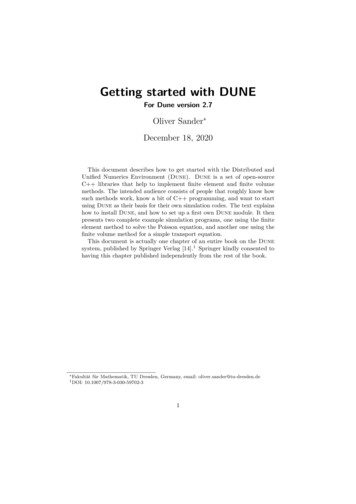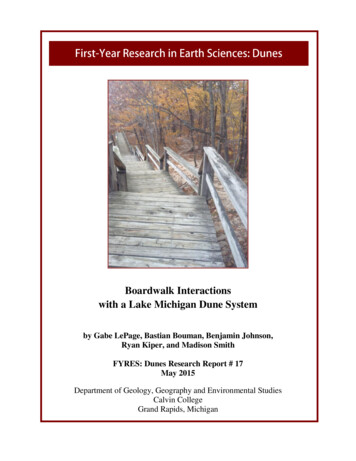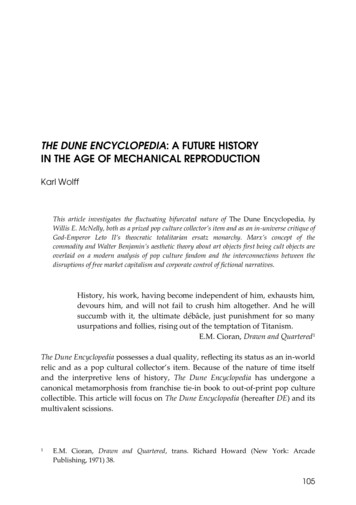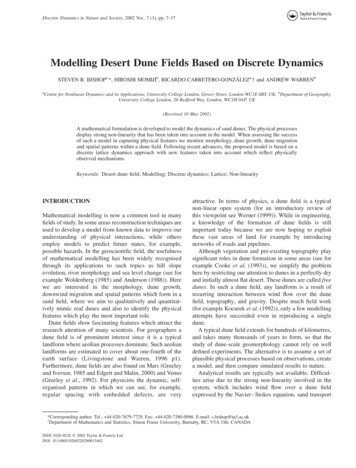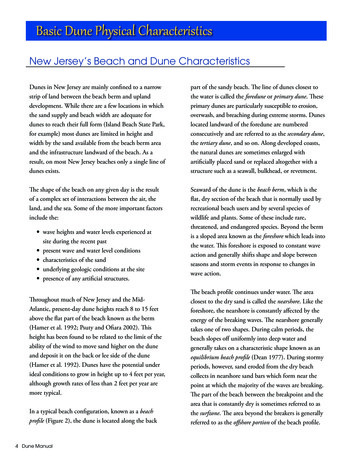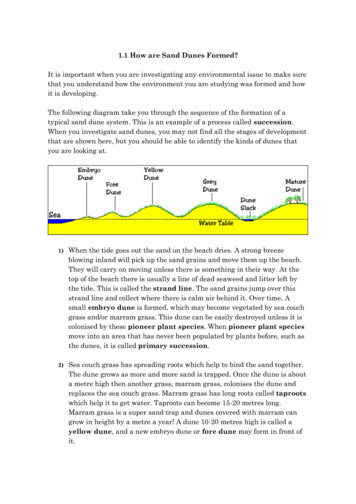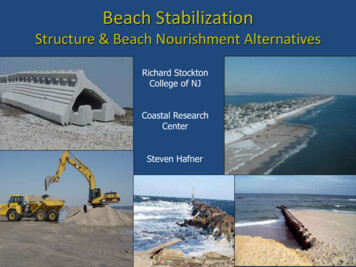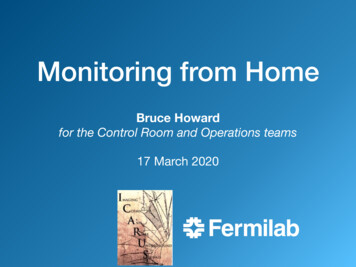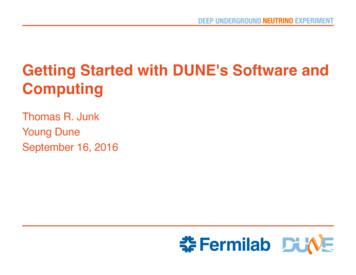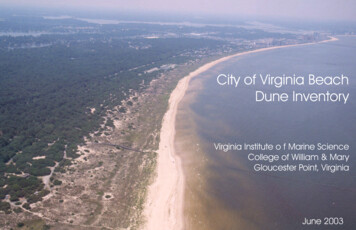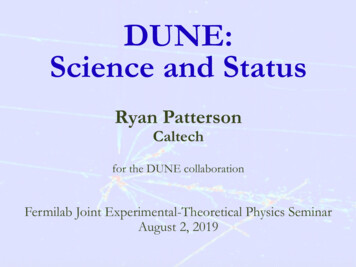
Transcription
DUNE:Science and StatusRyan PattersonCaltechfor the DUNE collaborationFermilab Joint Experimental-Theoretical Physics SeminarAugust 2, 2019
Neutrino oscillationsThree neutrino flavors𝜈edepends on 𝜈𝜇𝜈𝜏mixing matrix UPMNSmass-squared splittings mij2Observed using solar, atmospheric, reactor, and accelerator 𝜈 sourcesSun imaged with 𝜈(Super-K)Ryan PattersonCosmic raysDaya Bay NPP2FermilabDUNE: Science and Status
Flavor structure(mass)2 gauge symmetry flavor symmetry ? Ryan : Science and Status
Flavor structure U𝜇3 U𝜏3 ?(“maximal mixing”)approx. 1:1:1 ratio gauge symmetry (mass)2 Ue3 0(recent discovery) flavor symmetry ? uctdsbe𝜇𝜈e𝜈𝜇𝜏𝜈𝜏What flavor symmetry can produce this pattern ofmixings and masses, and how is that symmetry broken?More broadly: what are the dynamical origins of fermionmasses, mixings, and CP violation?Ryan Patterson4DUNE: Science and Status
Flavor structure Ue3 0(recent discovery) U𝜇3 U𝜏3 ?(“maximal mixing”)Experimental question:sin2 𝜃23 0.5 ?(mass)2Non-maximal mixing?If so, which way does it break?approx. 1:1:1 ratioStandard parametrization of PMNS matrix:Ryan Patterson5DUNE: Science and Status
CP violationNew source of CP violation required to explainbaryon asymmetry of universepart-per-billion level of matter/antimatterasymmetry in early universeNeutrino CPv allowed in 𝜈SM, but not yet observed due so far to the experimental challenge, not physics!Leptogenesis1 is a workable solution for the baryonasymmetry, but need to first find any leptonic (neutrino) CPvsin 𝛿 0 ?Leptonic CP violation?1Ryan PattersonM. Fukugita and T. Yanagida (1986); rich history since then.6DUNE: Science and Status
Are the electron-rich states 𝜈1 & 𝜈2heavier or lighter than 𝜈3 ?(mass)2𝜈 mass orderingFar-reaching implications for sucha simple question:- 0𝜈𝛽𝛽 and Majorana nature of 𝜈- Experimental approach to andinterpretation of m𝛽- Cosmology and astrophysics- Theoretical frameworks forflavor and mass generationP. Guzowski et al., PRD 92, 012002 (2015)Notice:An inverted ordering implies 1.5% mass degeneracy. Would hint at ? (cf.: 𝜋 /𝜋0)Ryan Patterson7DUNE: Science and Status
Flavor: A core problem for 21st century particle physicsDi Bari, Marzola, Re FiorentinNucl. Phys. B 893, 122 (2015)Flurry of theoretical work.Emphasis on genuine predictive power.Explicit connections between low energyobservables and leptogenesis.Often immutable preferences formass ordering and 𝜇/𝜏 asymmetryNeed precision PMNSmeasurements8Hagedorn, Meroni, MolinaroNucl. Phys. B 891, 499 (2015)Björkeroth, de Anda,de Medeiros Varzielas, KingJHEP 06, 141 (2015)Ryan Patterson
A next generation experimentfor neutrino science, supernovaphysics, and physics beyond theStandard ModelFar DetectorNear Detector(measure oscillated flux)(essential systematics control)Ryan Patterson91300 km baselineInitial beam: 𝜈𝜇 or 𝜈𝜇(selectable)DUNE: Science and Status
𝜈𝜇 “disappearance”Measure rate andenergy spectrum of𝜈𝜇 and 𝜈e 𝜈𝜇 and 𝜈eat Far DetectorFar DetectorNear Detector(measure oscillated flux)(essential systematics control)Ryan Patterson10Initial beam: 𝜈𝜇 or 𝜈𝜇(selectable)DUNE: Science and Status
Far Detector40-kt (fiducial) liquid argontime projection chambers- Installed as four 10-kt modulesSanford UndergroundResearch Facility (SURF) 4850’ level at SURF First module will be asingle phase LAr TPCRyan Patterson11DUNE: Science and Status
Early LateE fieldAnode3.5 mCathode
Inside ProtoDUNE-SPRyan PattersonArgon filling of ProtoDUNE-DP (underway now!)14DUNE: Science and Status
PerformanceProtoDUNE-SP Preliminary Stable operation at design voltage 180 kV10.8 Excellent LAr purity 5 ms e- lifetime. Req: 3 ms.0.6 Excellent signal-to-noiseU PlaneSNRInductionV n:38:10.4 Excellent light yield and linearityin photon detector systems0.200 0.5 – 7 GeV/c beam data collectedlast Fall (e, 𝜋, p, K)20406080100 120 140Angle-Corrected Peak Signal-to-Noise Ratio2 GeV electron showerRyan Patterson15DUNE: Science and Status
PIP-II groundbreaking: March 15, 2019
Long Baseline Neutrino Facility (LBNF) DOE/Fermilab hosted project with international participation Horn-focused beamline similar to NuMI beamline 60 – 120 GeV protons from Fermilab’s Main Injector 200 m decay pipe at -5.8 pitch, angled at South Dakota (SURF) Initial power 1.2 MW, upgradable to 2.4 MWRyan Patterson17DUNE: Science and Status
DUNE Near DetectorbeamdirectionCoherent design that draws from experience of currentand past long-baseline oscillation experimentsLAr TPC:Matches basic FD technology. Core 𝜈-Ar (and ν-e) samples.GAr TPC w/ ECAL: Magnetized. 𝜈-Ar events with low-threshold tracking, 4𝜋 acceptance.Provides spectrometry for muons exiting LAr.DUNE-PRISM:Off-axis movement of Ar detectors to vary incident neutrino spectrum.3DST:Fast beam monitoring in fixed on-axis position.Ryan Patterson18DUNE: Science and Status
ArgonCube (LAr TPC)2-by-2 demonstratorAn ArgonCube module(0.7 m 0.7 1.8 m)Simulated GAr TPC event with reconstruction3DST detector elements19
DUNE-PRISM Vary the incident neutrino spectrumby moving off-axis Break cross section model degeneracies Linearly combine off-axis samples tocraft “arbitrary” neutrino spectra- narrow Gaussian spectra- FD-like oscillated spectraUnprecedented reductionin XS model dependenceRyan Patterson20DUNE: Science and Status
Updated Sensitivity AnalysisIn the DUNE Technical Design Report:Major overhaul of all of DUNE’sphysics sensitivity calculations.Showing key results today.Ryan Patterson21DUNE: Science and Status
𝜈𝜇 CC(E𝜈 3.1 GeV)𝜈e CC(E𝜈 3.1 GeV)𝜈𝜇 CCtags: long muon track,decay electron at endsimulationsKey event types𝜈e CCtags: primary electron(EM shower)NC 𝜋0 (E𝜈 2.8 GeV)𝜈 NC (with 𝜋0) background!tags: multiple EM showers,photon conversion gaps,dE/dx at shower startRyan Patterson22DUNE: Science and Status
FD event samplessimulated eventFully automated FD simulation,reconstruction, and event selection Detailed G4 LBNF flux predictions G4 detector sim electronics response:- Draws fruitfully from other LAr experiments via LArSoft framework- ProtoDUNE data validation!Event selection / reconstruction Convolutional neural network selection- Based initially on NOvA’s “CVN” selection Energy reconstruction:Muons by range (or multiple Coulomb scattering)Electrons and hadronic showers by calorimetryAvg. resolutionsRyan Patterson𝜈e CC: 13%𝜈𝜇 CC: 18% (20% if 𝜇 uncontained)23DUNE: Science and Status
Selected FD samples at 7 yearsDUNE simulation𝜈e𝜈𝜇𝜈͞ e 1,000 𝜈e / 𝜈͞ eappearance eventsin 7 years!𝜈͞ 𝜇 10,000 𝜈𝜇 / 𝜈͞ 𝜇 eventsRyan Patterson24DUNE: Science and Status
Selected FD samples at 7 yearsDUNE simulationvariation withmass ordering𝜈e𝜈e𝜈͞ e𝜈͞ evariation with 𝛿CPRyan Patterson25DUNE: Science and Status
Sensitivity calculationsExample ND LAr samples (7 yr) Simultaneous ND FD fitting frameworkFramework ported from NOvA (“CAFAna”)and extended for DUNE case G4 simulation of LAr ND events withparametrized reconstruction included in the fit0.1 y 0.2𝜈 modeND samples binned in E𝜈,rec and yrec Exposure and staging assumptions- Technically limited schedule:1.2 MW 20 kton at start1.2 MW 30 kton after 1 yr1.2 MW 40 kton after 3 yr2.4 MW 40 kton after 6 yr0.6 y 1.0 mode𝜈- Equal 𝜈 / 𝜈 running- 56% operations up-timeRyan Patterson26DUNE: Science and Status
Systematic uncertaintiesNeutrino interactions Extensive suite of GENIE modelvariations (GENIE 2.12.10 with Valencia 2p2h) Heavily augmented with additionalmodel freedom- Theoretical and experimentalconsiderations, includingT2K, NOvA, MINERvA data- Additions relate to:QE Q2 dependence2p2h strength and E dependenceAr/C scalingpion multiplicities by channel𝜈e/𝜈𝜇/ 𝜈e differencesresonance modelingand moreRyan Patterson27DUNE: Science and Status
Systematic uncertaintiesNeutrino flux Uncertainties from beam transportand hadroproduction 𝜎 : 8% at oscillation maximum1 – 2% in Near/Far ratio(with significant correlations across energy)Base energy scale uncertainties(not shown: allowed variations with energy)Detector response Acceptance and energy response uncertainties Post-calibration expectations plus experiencefrom operating experiments. Not yet taking advantage of ND/FDcorrelations in fitsRyan Patterson28DUNE: Science and Status
CP violation and neutrino mass orderingCPv sensitivityMass ordering sensitivityUpdated sensitivities! Move quickly to potential CP violation discovery Rapid, definitive mass ordering determination 5𝜎 regardless of any other parameter choicesRyan Patterson29DUNE: Science and Status
Sensitivity versus timeCPv sensitivityMass ordering sensitivitySignificant milestones throughout beam-physics programNote: When a choice is called for, NuFit 4.0 (Nov 2018)best-fit parameters and/or uncertainties are assumedJHEP 01 (2019) 106, www.nu-fit.orgRyan Patterson30DUNE: Science and Status
Mixing angle 𝜃23sin2𝜃23 vs. 𝛿CPOctant determination at 10 years 5𝜎 octant determination possible(significance depends strongly on true value of 𝜃23)31DUNE: Science and Status
Precision PMNS𝛿CP resolutionsin22𝜃13 vs. 𝛿CP𝛿CP measured to 7 – 17 sin22𝜃13 resolution: 0.004 (4.5%)Single-experiment*precision oscillation measurement!Ultimate sin22𝜃13 precision competitivewith reactor measurements*solar parameters 𝜃12 and m221 are still inputs32DUNE: Science and Status
99% of energy released in a core-collapse supernova iscarried away by neutrinos (cf.: 0.01% carried away by light) Rich information embedded in neutrino signal: Supernova physics: core-collapse mechanism, black holeformation, shock stall/revival, nucleosynthesis, cooling, Particle physics: flavor transformations in core, collectiveeffects, mass ordering, nuclear equation of state, exoticaNeutronizationAccretionDUNE at 10 kpc: 3000 𝜈e eventsover 10 secondsRyan Patterson33CoolingGarching model (27 M )Argon target:Unique sensitivityto 𝜈e fluxS. Woosley and T. JankaNature Physics 1, 147 (2005)Supernova neutrinosDUNE: Science and Status
Analysis toolsMARLEY eventMARLEY event generator forsimulation of primary channel:includes detailed, data-driven modelof the relevant nuclear transitionshttp://www.marleygen.orgS. Gardiner, C. Grant, E. Pantic, and R. SvobodaFull detector simulation withCalorimetric energy reco.Using TPC signals with drift correctionPhoton-based calorimetry just as good!Incorporated into analyses soon.Ryan Patterson34DUNE: Science and Status
Example observablesNeutrino mass orderingsignature in neutronization burstOther 𝜈MO signatures in burst datahave more theoretical uncertainty(e.g., shock wave, collective effects) Leverage beam-basedvMO measurement!DUNE sensitivity to “pinchedthermal” spectral parameters*DUNE 90% C.L.(Only time integrated flux used here!)*Ryan Patterson35DUNE: Science and Status
Directionality10.25 MeV electron,simulated and reconstructed Prompt pointing to a supernova ishighly valuable information toastronomers:collection Catch early turn-on of EM signal Support observation of optically dim SN Era of multi-messenger astronomyinductioninductionDirection likelihood surface atDUNE for 10 kpc supernova𝜈e CC and 𝜈 e (elastic scatter) eventsChannel tagging can improve this further.Much better pointing with ES events!But only 7% of sample.36
Forward reconstructedBackward reconstructed4.5 pointing resolution(10 kpc progenitor) Several other low-energy neutrino measurements under study No time in this talk, but some discussion in Technical Design Report- diffuse supernova neutrino background- solar neutrinos- absolute neutrino mass from SN𝜈- Lorentz/CPT violationRyan Patterson37DUNE: Science and Status
Physics Beyond the Standard ModelMany avenues for searchesDUNE simulation63 MeV K e Baryon number violationGeneral feature of GUTs. Rich model space.Many search modes being explored in DUNE.𝜇 Updated simulation/reconstruction/analysis:More details and more channels in TDRK p K 𝜈Tracking and dE/dx for rejection of𝜈𝜇 CC background (p 𝜇 final state)10 cmDUNE simulation 0.5 bkgnd at 400 kt-yr, 30% signal efficiencyIf no signal: 𝜏/B 1.3 1034 yr (90% C.L.)n-n̄ osc.Spherical spray of hadrons with E 2Mn andnet momentum pF 300 MeVFree-neutron-equivalent sensitivity:𝜏free,osc 5.5 108 s (90% C.L.)Ryan Patterson3850 cmDUNE: Science and Status
Non-standard interactionsObservable as modifications to standard matter effects over DUNE’s long baselineDUNE300 kt-MW-yr Z′-mediated trident interactionsUnderlying interaction a possible explanation to the muon g–2 anomalyDUNE ND(6.5 yrs) Also: active-sterile mixing / PMNS non-unitarity / CPTv / heavy neutralleptons / large extra dimensions / dark matter (beam-induced & astrophysical)39
An international science collaboration1106 collaborators from 184 institutions in 31 countriesRyan Patterson40DUNE: Science and Status
Technical Design Report Detailed documentation of allscientific, technical, and managerialaspects of DUNE 2000 pages over five volumesSubmitted last week to Long Baseline Neutrino Committee andNeutrino Costing Group** two independent, international committees providing on-going oversight and reviewA major milestone for the collaborationND TDR will be a separate step, c. 2020Ryan Patterson41DUNE: Science and Status
ProtoDUNE-SP/DP operationafter CERN LS2 (2021) Will upgrade active detector elementsto match final production designs Collect expanded suite of beam dataFar site pre-excavation constructionis well underway by contractorFinal design of caverns and supporting infrastructureInstallation timeline to befinalized when the internationalproject is baselined.c. 2026 estimated startof FD operation42
SummaryDUNE: An ambitious international projectwith a broad physics program Unambiguous 𝜈 mass ordering. Leptonic CPv at 5𝜎 for most 𝛿CP valuesPrecision PMNS: a new era for flavorRich physics/astrophysics with supernova neutrinosWide-ranging searches for physics beyond the Standard ModelOne mile above DUNE continues tomeet key milestones.TDR to be releasedwidely upon conclusionof external reviews.Ryan Patterson, Caltech43DUNE
DUNE-PRISM Vary the incident neutrino spectrum by moving off-axis Break cross section model degeneracies Linearly combine off-axis samples to craft "arbitrary" neutrino spectra - narrow Gaussian spectra - FD-like oscillated spectra Unprecedented reduction in XS model dependence Ryan Patterson 20 DUNE: Science and Status
